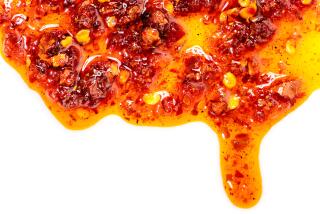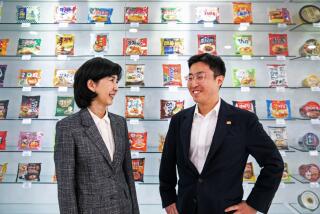Column: Heritage goes beyond chopsticks
The laughter starts before the noodles even hit the ground.
Frozen in mid-grasp, I watch a chopstick spin uncontrollably out of my hand, flinging droplets of sesame oil as it falls.
“Would you like a fork?” a waiter asks, staring at the mess.
“Mei guan xi,” I tell him, everything’s just fine.
The saying goes that if you drop your chopsticks while eating, it will bring you bad luck.
Well, I still don’t know how to use chopsticks properly, which is almost worse than not knowing how to use chopsticks at all.
Old habits die hard. The first time I tried them, it felt like a game. I found my own way of leveraging the two pieces of wood, crossing them (a major faux pas) and twisting my wrist 180 degrees to pick up a fried string bean. Ma and Dad left me to my own devices, happy they didn’t have to set the table that night with one of the four mismatched forks in the house.
My brother and I always had a choice, though. Steak for dinner? Definitely a fork-and-knife night. Hibachi? Maybe chopsticks. Salad? Cherry tomatoes were suddenly my worst enemy.
My parents, however, magically ate everything with the utensils they grew up using — lasagna, fries, soup, even toast.
It has always been the parents’ responsibility to teach their children chopsticks etiquette. Fortunately, mine didn’t hold me to that and gracefully sidestepped any scrutiny they may have encountered. I never turned the table into a drum set, and it just didn’t seem to matter. Not to my family, at least.
One friend has known how to use chopsticks since kindergarten, when the mother of a Chinese American classmate came in for a presentation and taught each student, hand by little hand.
Still, in a world where more than 1.5 billion people use chopsticks regularly, amused reactions are now a given: “You don’t know how to use chopsticks? But you’re Chinese!”
To compensate, perhaps, I take pride in proving that connecting to my heritage requires so much more than the obvious:
I can name Chinese spices by region and rejected the Americanization of my last name, insisting on pronouncing it shee-ah. Perfecting my Chinese was the only way to call Grandma on her birthday and speak without depending on dramatic facial expressions.
And when I do use chopsticks, I know not to stick them upright in rice like funeral incense. And picking up my bowl and shoveling food into my mouth is clearly out of the question.
On a recent trip to China, I squatted at my grandma’s 2-foot-high dining table, surrounded by my extended family. After my third messy attempt to pick up liang pi — glassy noodles soaked in bright red oils — my grandpa chuckled affectionately: “Your Chinese gets better each time we see you, but you’re still our little American.”
It was a good joke in the family; a quirk that wasn’t a problem until my debut in the professional world: a venture capital internship in Beijing.
The first morning at the firm sailed by smoothly enough, but then came lunch. The hot pot is fantastic, my supervisor was saying, unaware anxiety was growing over the boiling broth.
“Bu hao yi si!” I squeaked, as a piece of tofu catapulted out of my grip. This time, there was no family to laugh with me. My supervisor paused for only a second before politely asking about growing up in the U.S.
So much for first impressions.
The next visit home, it was back to the beginning. “Relax that first chopstick in the web of your hand,” instructed my dad, laughing at my vise grip with my pinkie and ring finger. “Its easier to control if you hold them loosely.”
The bottom one doesn’t move, said my mom, moving her top chopstick effortlessly up and down, inches from my face.
“It’s really not that hard. Just hold it like a pencil,” said my brother, who mastered chopsticks after understanding the physics. He grinned, deftly picking up slippery edamames one by one and placing them in my bowl.
My bottom chopstick and a ginger shrimp suddenly fell into the dessert porridge my dad was about to serve.
“It needed salt anyway,” he said, echoing everyone’s laughter.
China is still the largest producer and consumer of chopsticks, but the utensils’ popularity is worldwide. There’s even a company in the U.S., according to IBISWorld analysts, that has been manufacturing more than 208 million chopsticks a year to sell to the growing market.
Now everyone seems to know how to use chopsticks. My friends have even mastered the fancier ones made of glazed plastic, metal Korean chopsticks and the pointier Japanese ones that require precise control. Silverware just seems out of place — more cumbersome, they say, especially with Asian cuisines that come in smaller “dainty” pieces.
At an Asian fusion restaurant on the Westside, I am the only one asking for a fork.
Of course, my fear is that people inevitably think I’m making a statement about my identity — whether with or without chopsticks.
“Do you think you’ll ever learn?” my friend asks, as I give up on the noodles and take a stab at the scallion pancake.
No. Not until I’ve truly lost touch with my heritage — my sense of family — will two sticks possibly anchor me. Until then, I plan to eat however I please.
Twitter: @RosannaXia
More to Read
Start your day right
Sign up for Essential California for news, features and recommendations from the L.A. Times and beyond in your inbox six days a week.
You may occasionally receive promotional content from the Los Angeles Times.







